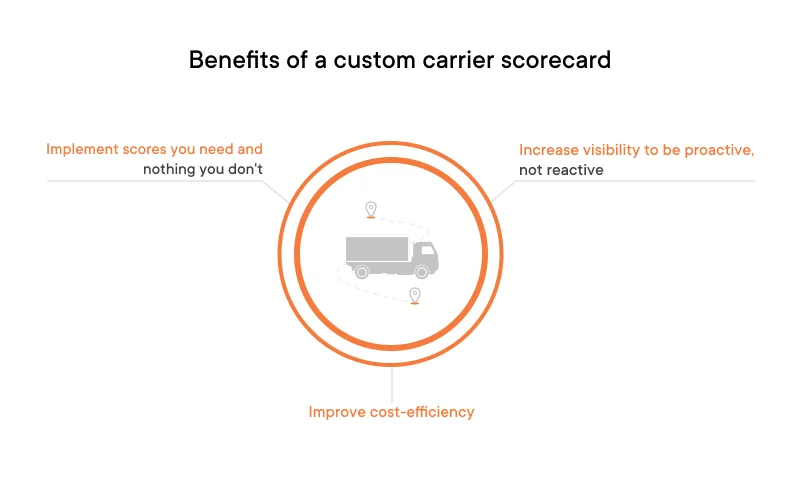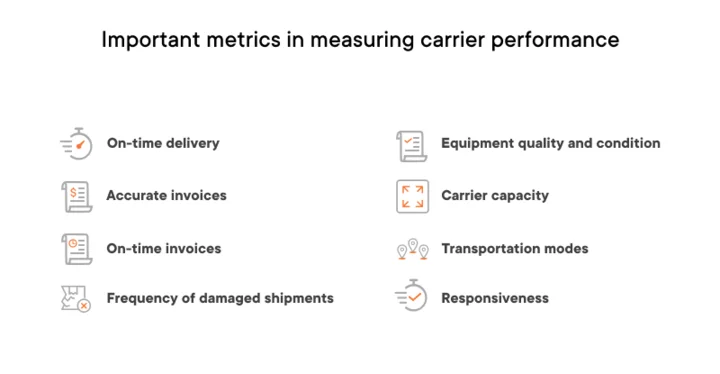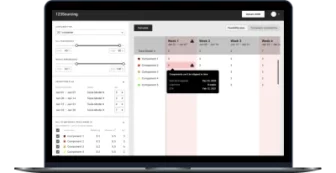
Carrier scorecard: how to effectively implement metrics to improve logistics services
Summarize:
There is a demand in the logistics industry for business process transparency to increase decision-making efficiency. Logistics companies are interested in new approaches and tools to track carriers’ performance and increase service visibility.
A carrier scorecarding tool evaluates carriers’ performance through tracking shipping KPIs and the health of your carrier relationships. Tracking this data allows companies to make informed decisions and improve cooperation in the supply chain management.
In this article, we share our insights into what metrics to consider while building a custom carrier scorecard process and how to efficiently increase shipment transparency.
Why is a carrier scorecard valuable?
Applying scorecards is a great approach to strengthen shipper–carrier relationships, boost a brand’s image, correct route forecasting, and increase the maturity of a company’s transportation cost management processes. Carrier selection is challenging and has lasting implications.
For example, the occasional ten-minute delay at the stock may not seem to be a problem. But if you apply this delay to the estimated delivery date for 10 carriers, you get an accumulation of delays and late deliveries. That results in a potential decrease in customer satisfaction and dozens of terminated contracts.
With such a considerable impact on day-to-day business operations, it’s important to select the carrier that will best fulfill your supply chain efficiency needs and capacity requirements so you can meet customers’ expectations.
To begin, let’s look at the topic from the perspective of the current market situation.
Set up data pipelines to gather accurate supplier-carrier information
Our data engineering company servicesLimitations of traditional carrier performance tracking
Companies currently do everything from old-fashioned solutions to the hottest new trends to track carrier performance. It can be difficult to increase a company’s efficiency if you choose the wrong approach to move forward. There are several ways to track carrier performance that hardly lead to sustainable productivity.
Manual KPI tracking in Excel
This approach leads to a time-consuming workflow that’s prone to human error. It’s difficult to rely on data from a document you can hold in your hand that ages fast because of the long time required for data collection.
With such an Excel document in your day-to-day business operations, you can’t keep carrier performance high and keep up with the ever-evolving market. Big data services can address these challenges by automating data processing, providing real-time insights, and ensuring the accuracy and scalability needed to manage complex shipping metrics efficiently.
Overcomplicated enterprise systems
Buying a ready-made solution looks like the best way out of a situation where you need to increase efficiency. Such solutions are usually robust and offer a variety of tools and user interface capabilities that can be customized.
The downside here is an abundance of potentially useless carrier scorecard tools for specific tasks of providers and forwarders. Another pitfall is the price of large software products.
Basic off-the-shelf solutions
There’s always a third option, namely, to buy a solution with the right modules for your business needs. This is often enough to make your business feel comfortable at the current scale. But if your business grows, you’ll need to not only automate processes but also precisely gather all data in one place from disparate modules of your existing software.
Contrary to the approaches mentioned above to effectively track carriers’ performance, there is a more cost-effective solution: a custom transportation carrier scorecard module that can be easily integrated into your existing system and can collect all the necessary data in one place.
Increase supply chain visibility by enhancing your logistics data visualization capabilities
Read the article on logistics dashboardsWhy build a custom carrier scorecard?
The quick answer here is that a customized carrier performance evaluation tool is built to meet your company’s specific needs. There are strong benefits to creating a customized scorecard. The most significant factors are the ability to:
Implement scores you need and nothing you don’t. With a customized module, you can track only those carrier performance metrics that directly address your needs. A targeted scorecard will allow you to assign the most qualified carriers to routes and tasks. In addition, by implementing only the right modules, it’s easier to integrate the modules and provide a smooth workflow.
Collect all real-time data in one place. A custom module allows you to save all data from different systems of your software. All sensitive data will be in one place, enabling you to achieve more accurate and error-free analytics.
Improve cost-efficiency. You can integrate a custom scorecard module into your existing software efficiently and cost-effectively. As you don’t need to pay for software upgrades you don’t need, you can invest only in critical features that guarantee your long-term growth. Moreover, a custom scorecard module gives you centralized access to all other modules and integrations from an intuitive and powerful admin panel.

Now that we’ve outlined the main benefits of custom carrier scorecards, let’s look at the important KPIs in scorecard creation.
Learn how to build cost-effective transportation routes
Read the article on route optimization solutionsCarrier scorecard template
Get a customizable example of the carrier scorecard that can help you grasp the essence of carrier performance to increase transportation visibility and decrease transportation costs. We’ve designed it in PDF, but upon request, we can also provide you with diverse carrier scorecard examples in Excel.
Key metrics to track carrier performance
Different sources claim that transportation costs may vary from 10 percent to 40 percent of the total product cost, which is a major expense for any company. Including the most significant KPIs helps to keep transportation costs affordable and increase the effectiveness of freight carrier scorecards.
You should start identifying metrics that measure the performance of carriers according to your company’s needs. These carrier scorecard metrics will give you objective data, leaving no room for assumptions or biases. We consider the following eight logistics scorecard metrics to be the most important in measuring carrier performance with a scorecard:

- On-time delivery. The level of delivery services, namely the percentage of on-time deliveries, provided by a third-party logistics company, is one of the fundamental criteria you should consider when choosing an efficient carrier. If you rely on timely deliveries, delays may not only reflect poorly on your brand but also lead to the loss of customers and sales. So as not to compromise your return on investment and reputation, don’t blindly trust a carrier to keep deliveries on schedule.
Learn how to help customers get quick and accurate information about their shipment
Read how to build a customer portal for logistics- Accurate invoices. Inaccurate invoicing can significantly increase shipping costs, but with proper validation processes, these errors are preventable. According to Global Trade, incorrect freight bills are found in about 5 percent to 6 percent of all invoices. A study of nearly 250,000 LTL invoices revealed that 42.8% of errors were due to inaccurate accessorial charges, highlighting the need for meticulous auditing.
- On-time invoices. Keeping invoices accurate is just as important as receiving them on time. When invoices are overdue or even missing, there are problems with accruals. Updating billing commitments on time helps you maintain cash flows, effectively manage risks, plan for future growth, and forecast accurately. A carrier scorecard evaluates a carrier’s ability to bill correctly and promptly, which is critical to making an informed and unbiased decision.
- Frequency of damaged shipments. Your revenue and reputation also depend directly on the frequency with which goods are damaged in transportation, as this means returns, dissatisfied customers, and claims filing. Namely, you should keep not only a record of the number of damaged goods but also track the percentage of goods damaged to determine a carrier’s delivery quality and ensure enhanced customer satisfaction. This metric can also uncover the need to modify packaging to reduce the possibility of damage. When tracking the frequency of damaged shipments, it’s especially important to provide feedback to the carrier so they can find weaknesses in their work and fix them.
- Equipment quality and condition. This equipment metric can directly affect on-time delivery and product quality for the end-user. Assessing the condition of a carrier’s equipment gives you a better idea of the carrier’s service quality and what kind of cargo the carrier can handle.
- Carrier capacity. Many third-party logistics companies choose a carrier based on price and reputation but overlook capacity. When a company can’t ship goods due to a lack of capacity, it’s not just unpleasant but ultimately leads to lost sales. The ability to track capacity will allow you to be proactive during critical times: vacation season, natural disasters, or economic fluctuations. By tracking capacity, you will be able to determine the best carrier, compared to others, for a particular shipment and uphold brand expectations.
- Transportation modes. You can divide carriers according to the type of containerized cargo they handle: less than container load (LCL) and full container load (FCL). By dividing carriers into those who prefer LCL and FCL, you can do a micro-level comparison, guaranteeing that you choose the best shipment option for each cargo type.
- Responsiveness. The responsiveness metric is simple, but at some point, it starts to create tension between you and the carrier. If you know how long it takes a carrier to respond to occasional supply chain disruptions, you can measure responsiveness. It’s ineffective for your business if you have to contact the carrier multiple times to resolve an occurred issue.
This list of delivery performance KPIs is far from complete, and the need for them depends on your priorities. After selecting a vendor to build a scorecard, they will prioritize your needs so your trucking KPIs contribute to better customer service responsiveness and lower costs.
How to build a custom scorecard module
At Yalantis, our experts know what steps to take when building a custom vendor scorecard to conduct an effective carrier performance check and ensure carrier safety. Explore the following steps we take:
- Determine key performance indicators (KPIs) when assessing carriers for your particular business case.
- Determine where all necessary data should be stored.
- Analyze which data is already available and which data is still not being collected or is not being collected automatically.
- Assign user roles, including roles of carrier management, who define and implement key performance indicators with carriers, to ensure the performance rate.
- Determine the frequency of using this data to make better-informed decisions. Analysis of such data can be used with each order, for example, or once a month.
- Once you’ve built a module, it’s worth considering the stages of its use.
How to use a custom carrier scorecard effectively
If you’ve already determined how to analyze your carriers through KPIs, the next move is to follow steps to tailor a scorecard and put it to use.
1. Automate the gathering of comprehensive carrier data
An obvious first step that companies need to take is to collect data. While everything may be clear with regards to collecting information about a shipment when it’s in the warehouse or on a fleet vehicle, the real work of a metrics system begins when the shipment leaves the dock. This is where companies need to connect to the systems of their supply chain partners. This step is crucial to create an accurate scorecard by automating the collection of data, which is then displayed in an easy-to-view dashboard.
Explore the benefits of robotic process automation for logistics use cases
Read about RPA for logistics2. Analyze data continuously to identify vulnerabilities
Raw and disparate data is nothing more than a pile of facts and figures. However, by using data analytics and applying advanced analytics services, you will be able to correctly interpret the data. By building scorecards, you will be able to realize weaknesses that are not noticeable without automation and analysis. With advanced analytics solutions, companies can benchmark metrics to find the most profitable carrier relationships.
Discover the specifics of BI and advanced analytics solutions for supply chain data analysis
Read the article3. Keep your scorecards intuitive to power exceptional user experiences
Scorecards are a reliable resource for visually identifying performance issues. For example, you can display red indicators where a carrier does not meet specified standards. This way, you can get an instant idea of which operators to use for thousands of shipments.
All these steps help both shippers and carriers. As a shipper, you can make better-informed decisions, while as a carrier, you can track your responsibilities using accessible and updated carrier or shipper scorecards.
Learn about HOS electronic logbook solutions for the US, Canada, the UK, and Australia
Read the articleAdvanced tools for transportation optimization
Once you’ve finished building your scorecard’s basic functionality, you may also want to consider an improved functionality list. A reliable vendor will consult you on what tools you should implement to enhance productivity. We suggest considering the following:
- Use predictive modeling to identify carrier costs based on various scenarios.
- Link scores from a freight carrier scorecard to other freight forecasting tools to get actionable market insights.
- Improve carrier performance with real-time reporting to provide an aggregated view of carrier performance data dynamically updated through API integrations with multiple carrier systems.
- Use improved exception management views that help you prioritize specific delivery issues by using filters to highlight or refine information.
- Apply machine learning data to proactively identify risks of delays and exceptions to provide complete order transparency.
- Use a cyber protection approach to build secure solutions.
- Implement intelligent risk management tools to receive alerts when network outages occur.
- Integrate, optimize, and digitize existing modules.
As you can see, building a valuable scorecard is impossible without a thorough analysis of particular business needs and advanced tools. Suppose you’re unsure how to create a custom module that integrates with your existing software to provide process transparency. In that case, you can enter into a secure service-level agreement with the Yalantis team. Our specialists have extensive experience creating secure and data-driven solutions with deep customization under tight deadlines.
READY TO BUILD A CUSTOM CARRIER SCORECARD? Choose the right experts
See our logistics expertiseFAQ
How do I ensure fair and unbiased carrier evaluations?
Use objective, clearly defined metrics and apply the same scoring logic across all carriers. For instance, if you have a few slow carriers and some more who transport goods faster, with the same performance evaluation metrics, you’ll be able to evaluate their overall performance in an unbiased and comprehensive way. Plus, you should ensure your data sources are clean, consistent, and free from manual bias.
What tools or systems can automate scorecard reporting?
You can integrate carrier scorecard logic into your TMS, ERP, or custom logistics platform. BI tools like Power BI or Tableau, or custom dashboards powered by data pipelines, are often used for visualizing performance in real time.
Can carrier scorecards help reduce shipping costs?
Absolutely. You can identify inefficiencies, negotiate better rates, and choose the most cost-effective carriers by tracking key cost-related metrics, like fuel surcharges, accessorial fees, and invoice accuracy.
How often should I evaluate carrier performance?
Ideally, you should review performance monthly or quarterly to catch trends early and take corrective action. Real-time dashboards or automated alerts can also help you act faster on poor carrier performance.
Rate this article
3.3/5.0
based on 12 reviews







